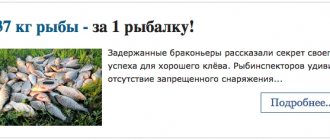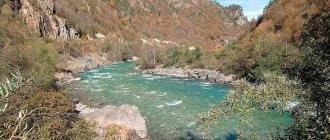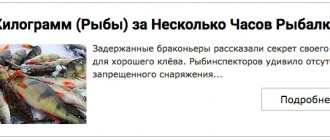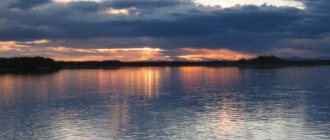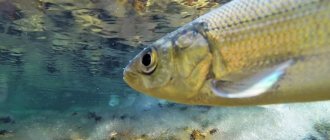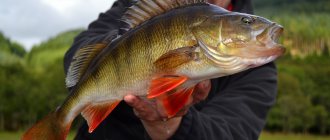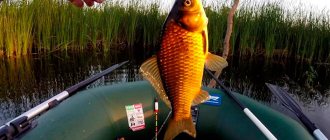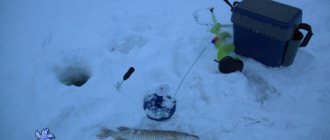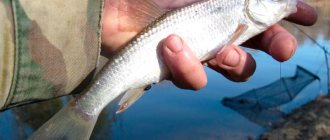Transbaikal region and Chita
They are famous throughout the country for a fairly large variety of fish in their rivers and lakes.
The Transbaikal region is famous for the richness and purity of nature. There are a large number of rivers and reservoirs here. In the territory of Transbaikalia, tributaries of the Yenisei and Lena flow, the Amur originates here, there are many small rivers and rivulets. There are many lake systems here, the largest of which are: Toreyskaya, Ivano-Arakhleiskaya, Kuando-Chara. Reservoirs vary greatly in depth, vegetation, and water composition, so there is a wide variety of fish living in them - more than 20 species. Basically, the fish in Transbaikalia are different from those found in central Russia. The rivers are dominated by grayling, lenok, and taimen, although roach, perch, and pike are also found. This is a great place for fly fishers and spinners.
Reservoirs of the region
Fishing in the Trans-Baikal Territory
The largest rivers in the region are Gazimur, Kalar, Ingoda, Shilka and Nercha. Their length is more than 500 km. The Amur begins here. Most of the region's rivers are relatively small, but during floods and after freezing, many of them can be of interest to amateur fishermen.
The uniqueness of the lakes of the Trans-Baikal Territory is that they form interconnected systems. Vivid examples of such systems are the Ivano-Arakhlei system of lakes, as well as the Torey lakes. The largest lake of the first water system is Arakhlei. The second system includes lakes Zun-Torey and Barun-Torey, which flood widely during rainfall and spring melting of ice, and by the end of summer they can dry up completely. If you don’t want to travel far from Chita, then you can visit the Karpov Lakes. They are relatively small, the banks are not well-maintained, but are ideal for outdoor recreation and fishing. You can also pay attention to Lake Kenon.
Fishing on the rivers of Transbaikalia
The taimen is considered the symbol of Transbaikalia. This is a real river predator, catching which is the goal of any enthusiastic fisherman. Taimen are caught mainly with spinners, and they are quite large in size. The best time for fishing is autumn. The best bait for taimen is traditionally considered to be a “mouse” - an imitation of a mouse swimming across a river. Moreover, taimen peck at the “mouse” both day and night. It’s hard to confuse the feeling when a taimen bites with something else. This is a fighting fish and it takes a lot of effort to defeat it.
Lenok fish, which is caught with a spinning rod, is also loved by fishermen. It is smaller than taimen, but is similar in habits to it and usually lives in the same places.
Grayling is also very popular. It is also smaller than taimen. Grayling is caught by spinning and fly fishing using small spinning baits. It is also possible to fish with a fishing rod, both from a boat and from the shore, usually with a wire. For fishing with a rod, artificial flies or local natural live bait are used.
In the spring, large schools of fish go to spawn in the upper reaches, and in the fall, after spawning, they slide down the rivers. During these periods, fish actively bite and are caught. In winter, despite the severe frost, ice fishing is popular. Under a thick layer of ice, the rivers do not freeze, and burbot, dace, grayling, pike, and perch are caught. During the spawning season, at the beginning of summer, certain restrictions on fishing apply.
The Shilka River is especially popular among Transbaikalia fishermen. In terms of fish stocks and diversity, Shilka occupies one of the leading places in the region. Chum salmon and beluga come here from the Amur; you can even catch large sturgeon using a spinning rod. But, in any case, fishing on the Transbaikal rivers is usually a good catch and great pleasure.
Fishing on the lakes of Transbaikalia
Lakes in the Trans-Baikal Territory are usually complex water systems where the lakes are interconnected and fish move from one to another. They say the bigger the lake, the bigger the fish you can catch.
Fishermen of Transbaikalia are very fond of the Ivano-Arakhlei lakes. The water body stretches for tens of kilometers. Lakes differ from each other in size, depth, water composition, and vegetation. Here they catch perch, chebak, crucian carp, and pike. Fishing on the lakes is popular at any time of the year.
Lake Nichatka, which is also called a fish lake (from the word “nicha” - fish), is also respected by fishermen. Lake Nichatka is one of the deepest and cleanest lakes in the region. Here you can catch not only pike, perch, goby or burbot, but also whitefish, taimen, grayling, and davatchan. When you go fishing on Lake Nichatka, you can be sure that your catch is guaranteed.
There are many wonderful places for fishing in Transbaikalia. There is only one problem - not all of these places are easy to get to. Sometimes the only way is by motorboat. But in summer, when the water is low, this can also be difficult.
The lakes of the Trans-Baikal Territory are entire water systems located beyond Lake Baikal. These are the Ivano-Arakhlei system of lakes and the Torey lakes. The system of the latter includes unique closed lakes connected to each other - Zun-Torey and Barun-Torey. These water systems are characterized by unstable water levels. During rainy periods, their area in general reaches 880 square meters. km, in dry summers they dry out almost completely. In the Ivano-Arakhlei system of lakes, the largest is Arakhlei. Its area is more than 58 sq. km.
Fishing in the Trans-Baikal Territory is mainly fishing for such fish species as ide, grayling and lenok. But fishing for this fish is not always allowed. During the spawning period, at the beginning of summer, restrictions apply. Most of the fish are caught on the lake, which is little known. It is not very large, but the very name that was given to it in the old days indicated that fish were found in large quantities in the lake. Lake Nichatka is home to not only the species common in the region, but also pike, pike, perch, taimen, davatchan, goby, burbot and others, including salmon. The list can still be continued. Fish Lake - this is another name for Nichatka; it is an obligatory and rich catch of fish. The lakes of the Trans-Baikal Territory always offer good fishing, with the exception of the spawning period.
general characteristics
In Transbaikalia there are a huge number of large and small rivers where you can very effectively catch a wide variety of fish. However, the region as a whole is characterized by one serious problem - due to underdeveloped infrastructure, not all reservoirs can be easily reached.
One of the most effective vehicles that can solve this problem is a boat with a motor, however, in the summer, when the water level is low in almost all bodies of water, the boat is not able to pass everywhere. On the other hand, there are a sufficient number of deep rivers, any point of which can be reached without problems with this craft.
The most productive time for fishing in Transbaikalia is autumn. At this time of year, fish, preparing for the cold winter, are very willing to go to artificial baits. Therefore, at this time there is a real paradise for anglers using spinning rods.
Fish in Transbaikalia have significant differences in species composition from fish not only in the rivers of Europe, but also in Western Siberia. Species such as taimen, lenok and grayling predominate in local reservoirs. However, one should not think that there are no fish here at all, characteristic of the middle zone; In the reservoirs of Transbaikalia you can find pike, perch, carp and burbot.
Among the characteristic “local” fish, the most interesting prey is taimen. This strong fish is an uncompromising predator, nicknamed the “Amur shark”.
Its weight can reach 70 kg, and its dimensions can reach up to 2 m. Taimen are caught using a spinning rod using various spoons or artificial “mouse” baits, which got their name because of the appearance of this rodent swimming on the surface of the water. Taimen usually hides in ambush behind some large obstacle, from where it attacks its potential victim.
Not all fishermen are able to catch taimen. Taimen has such a powerful grip that in the first moments of fishing it, it is absolutely impossible to reel in the fishing line - the clutch only gives it away. Naturally, fish of this class require extra-heavy class rods.
Another interesting fish of Transbaikalia is lenok. Lenka is much smaller than taimen; The maximum recorded weight of the caught fish is about 8 kg with a length of about 70 cm.
Lenok moves mainly in small flocks, although it hunts in approximately the same way as taimen - attacking alone from an ambush.
Grayling fishing is no less popular in Transbaikalia.
Grayling is a relatively small fish that rarely weighs more than 6 kg, and its length does not exceed 50 cm.
Grayling is also caught mainly with spinning rods, but fishing rods are also often used. In this case, small baits such as flies or streamers are used; the advantage of the latter is that it can be used to fish both fly fishing and using a spinning rod.
In spring, most fish travel along deep rivers to spawn in the upper reaches. This movement is carried out in large schools, while the fish continue to actively and feed a lot, and, naturally, are also excellently caught.
In the summer, when the water level drops significantly and the fish return from spawning grounds to their usual habitats, the bite is significantly worse. However, the short period of summer quickly gives way to autumn and the intensity of the bite returns to the state familiar to fishermen.
But one should not think that fishing in this region freezes in winter. Despite the harsh winters, active fishing is carried out in Transbaikalia and from under the ice. Despite severe frost and a thick layer of ice (sometimes reaching up to 1 m), there is no fish kill in winter, since the flow in the rivers remains constant. It is in winter that a significant share of the catch of pike, burbot, dace, grayling and perch occurs.
Fishing in Transbaikalia, especially in winter, requires a very serious level of training and technical support. For example, for winter fishing, the presence of a motor drill or chainsaw is often mandatory.
Fishing Features
Fishing in Transbaikalia
There are a large number of large reservoirs located in this region. On their territory, all fish are in constant migration. Thus, she is constantly in search of food. In this regard, before you go fishing, you need to familiarize yourself with the features of the reservoir where you are going to fish. During the fishing period, it is recommended to systematically observe how the fish move in the reservoir.
This way you can find better fishing spots. It must be remembered that fish do not live in local reservoirs along the entire riverbed. But its movement is carried out not in dense schools, but in small paths. It is in this regard that the release of fish will directly depend on the nature of the river, the depth and speed of the current. For example, in the reaches there is a fairly large depth. It is in this area that large fish like to live. A weaker current, as a rule, is inherent in the middle part of the reach. In such a place you can stumble upon a large concentration of small fish. For example, it could be a chebak, a minnow or a sorog.
In the Trans-Baikal Territory, a large number of rivers are filled with fish that come here to spawn. Spawning itself for a large number of fish occurs throughout May and June. But burbot prefers to spawn directly in the cold season. Its last spawning takes place directly in January. During the spawning period, a large number of fish have a very active diet. Thus, the fish stock up on food for the entire spawning period. As soon as the spawning is over, the fish's appetite is restored again.
For example, in pike, carp and lenok, after spawning, the resumption of feeding is observed after twelve days. But in grayling and perch, gorging is constantly observed. Many fishermen believe that wind does not affect the feeding process of fish. But this is far from true. All the greenery that is located on the banks of reservoirs serves as excellent food for fish. When there is wind, various insects fall from the trees into the water, which the fish subsequently feed on. Thanks to the good food supply in the reservoirs of Transbaikalia, lenka, whitefish, pike perch, and pike feel great.
If the spring in Transbaikalia is very cold and long, then you should not expect good fishing. The thing is that at this time all the fish go to great depths and stop responding to any bait. But as soon as it starts to get a little warmer, the situation on the rivers immediately changes. The bite is starting to gradually stabilize. As soon as the ice drift is over, the water in the rivers becomes very clean and light. It is during this period that a large number of fish begin to eat very strongly.
The most popular fish in Transbaikalia is taimen. As a rule, it is caught using spinners, oscillating or rotating. Experienced fishermen advise taking a larger spoon for this fish. But in order to catch lenok you will need to use a spinning rod. Very often lenka can be found in the same places where taimen stands. Both types of fish are caught directly using a spinning rod. Another popular fish in this region is grayling. Many people use fly fishing or spinning to catch it. The fish itself is small in size. In this regard, anglers use spinning baits, flies and streamers.
Throughout the winter, ice fishing is very popular in these parts. In the cold season, grayling, burbot, dace, pike and large perch bite well. Many fishermen catch their trophy fish at this time.
When it rains like a wall, the fish don’t bite either, but after the rain the best bite begins. The fish bite well in inclement weather on the eve of rain.
In July the water gets very hot, so the fish bite well before sunrise; after the night the water cools down a little. At this time, on the outskirts of deep holes, the fish are good at taking live bait or a piece of small fish attached to a hook.
In the grass that has risen to the water surface, you can easily catch large predators hunting for all kinds of small fish. Along the outskirts of muddy creeks, especially where small streams flow into large rivers, it is also not difficult to catch fish - using small spoons or a floatable fishing rod.
The Baikal omul lives in waters containing silt. In it he finds the smallest crustaceans and insect larvae. Omul loves the upper layers of water heated by the sun, which makes fishermen happy. There is enough fat in omul - this is what helps the fish survive in the icy Baikal water in winter.
As the water gets colder, burbot becomes active, and in deep holes, near steep banks, it is caught with a donka or mugs. Transbaikal places are famous for their rich and clean nature. The reservoirs of the region are quite different in depth, vegetation, and water composition. Therefore, there are many varieties of fish found here - burbot, omul and others.
Fishing in Transbaikalia in autumn and winter
While in other regions of the country fishermen look forward to spring, when the fish begin to behave actively, you can come to Transbaikalia not only in the spring, but also in the fall, when the real feeding of fish begins. It is fishing in Transbaikalia in winter and late autumn that is a unique opportunity to organize a real hunt for fattening taimen, for which fishing enthusiasts travel many thousands of times. This fish rightfully deserves respect and it is not for nothing that it is considered a real fighter, since not everyone can cope with this huge predator, so if you have little fishing experience, it is worth practicing on other types of fish.
They catch taimen using a spoon, and in this case size matters - given the size of the fish itself, it is worth using large-sized bait. Before you go looking for taimen, you should talk to local fishermen, who will advise you to make a special bait called a “mouse”, as it imitates a rodent swimming across the river. The first bite of taimen can throw even experienced fish off balance, so you need to prepare carefully for a meeting with a giant.
Fishing in Transbaikalia in spring and summer
A huge number of rivers and small streams flow through Transbaikalia, and among the wide variety of “cool” places, fishing in Transbaikalia on Ingoda is especially popular, where you will meet another representative of the local ichthyofauna. This is a lenok, which can also be caught using a spinning rod. The fish is somewhat smaller than taimen, and smaller fish prefer to live in a school, while large lenok lives alone, so it is more difficult to catch.
Fishing in Transbaikalia in the spring is also a unique opportunity to organize a grayling hunt. This local delicacy can be called a legend, and fishermen from all over Russia and other countries come to try their hand at grayling fishing in Transbaikalia. You can catch grayling using a spinning rod or a fly rod; you can even use a regular float rod for this. Grayling, although it is smaller in size compared to taimen and lenok, is difficult to obtain without certain skills.
In addition to a large number of rivers of different sizes, in Transbaikalia there are a large number of reservoirs with stagnant water, so fishing in Transbaikalia on lakes, which are entire water systems, is no less popular, and it is often difficult to predict which representative of the local ichthyofauna you will encounter, since fish presented here in a wide variety. Among the numerous lakes, it is worth highlighting the Torey lakes and reservoirs of the Ivano-Arakhlei system.
Union of Fishermen of Transbaikalia, Fishing in Transbaikalia
In harmony with nature, in harmony with yourself!!!
001. “If fishing weren’t so calming, I would have killed everyone long ago...” 002. “The size and test of the spinning rod is a confirmation of manhood...” 003. “On the worst fishing - better than at home!” 004. “Don’t make me laugh, otherwise my tip is shaking! (Looking blankly at the spinning rod)" 005. "The most catchy lure will still remain in the store." 006. “Does a fisherman need much on Akhtuba? The Orthodox list is enough." 007. “No matter how many spinners you have, someone else’s box is still more catchy!” 008. “No matter how you prepare for fishing, the fish will be caught in the wrong place, and not with what you’re fishing for...” 009. “It’s better not to weigh a large fish, otherwise it will lose half its weight” 010. “If you If you are ready to eat your own bait, then the fish will definitely not eat “IT!” 011. “If you want your gear to serve you longer, then just don’t take it fishing.” 012. “So that the buoy stands and the boats float! (Mikhail Evdokimov)" 013. "Fishing is life! Work and family are hobbies. (John Springer)" 014. "The big fish is the one you caught, the rest are small." 015. “Fishing is like football.. Sometimes we take it, sometimes it takes us.. More often than not.” 016. “Bite is a fickle, unpredictable and... difficult to prove.....” 017. “Only those fishermen who have no wit tell the truth. (Dostoevsky)" 018. "I have never met a spinning player who cared what the floaters said about him. (Bulatovich)" 019. "In a real fisherman there is hidden a child who wants to play. (Nietzsche)" 020. "Any obstacle to fishing only strengthens the desire for it. (Shakespeare)" 021. "Cast a spoon and you will see where the wind is blowing. (Selden)” 022. “The only way to get rid of thoughts about fishing is to go fishing.” 023. “Nothing confuses concepts about fishing more than the recognition of authorities. (Tolstoy)" 024. "Great is the fisherman who makes his listeners forget about the details. (Bernard)" 025. "It is not the original fisherman who imitates anyone, but the one whom no one is able to imitate. (Chateaubriand)" 026. "In fishing, any doctrine is an alibi with which the fisherman tries to justify his own limitations. (Camus)" 027. "Never speak disrespectfully about a spinner. He is criticized only by those who are not given the opportunity to catch him. (Wilde)" 028. "Nature has given us a short life, but the memory of wonderful fishing is eternal. (Cicero)" 029. "He who has seen fishing can say that he has seen life. (Bucharsky)" 030. "Women inspire us to fish, but they prevent our inspiration from being realized. (Wilde)" 031. "Being a fisherman nowadays is very expensive. (Harrington)" 032. "A fisherman who can be understood is no longer a fisherman. (Maugham)" 033. "The best way to help fishermen is to become one of them. (Hancock)" 034. "Whoever buys extra gear ends up selling what he needs. (Franklin)" 035. "Nowhere do you feel the futility of people's hopes so strongly as when fishing. "036. "The best cure for fishing is fishing. (Meek)" 037. "Being a fisherman is bad because it takes up all your time. (Koning)" 038. "You can see a real fisherman even when he is naked. (Lec)" 039. "The one who said “stupid as a spinner” apparently does not know trollers. (Waldorf)" 040. "Fishing is the main of the great religions of the world. (Beers" 041. "You cannot become a good fisherman without a certain amount of stupidity. (Nightingel)" 042. "What is required of a fisherman first of all is patience, courage is second. (Napoleon)" 043. "When fishing, everything is exactly like in the Boy Scouts, but the Scouts are under the supervision of (Johnson) adults. (Clark)" 044. "If there were no fishermen, they should have been invented... (Zangwill)" 045. "A fisherman needs a good memory and a firm belief in the lack of memory of others . (Ipokhorskaya)" 046. "He mastered spinning, but in a particularly perverted form. (Vansovich)" 047. "A real fisherman is always a fisherman, even when fishing. (Genin)" 048. "It's not enough to go fishing, you have to still have a job there. (Yablons
Publications: 33
Tips for fishing in the Trans-Baikal Territory
For fishing, it is better to choose reservoirs that are located outside of large populated areas, since a large number of vacationers and the proximity of industrial enterprises pollute both water and soil. It is better to choose the Torey, Ivano-Arakhlei or Kuando-Chara lakes for a vacation in nature. These lakes stretch for many kilometers and differ from each other in depth, size and other characteristics, which affects the species composition of the fish living here. Often fish move from one lake in the system to another along canals and channels. The deeper and larger the lake, the larger the fish you can catch in it. Of course, you will need to spend time getting to the lakes, but the natural beauty of the places and the abundance of fish are worth it.
The species diversity of fish in the reservoirs of the Trans-Baikal Territory is somewhat different from what residents of central Russia are used to. For example, in Lake Arey, the most common fish caught are amur, aukha, topgazer, snakehead, kaluga, yellowcheek, silver carp and sleeper. On Lake Doroninskoe there is a high probability of catching chebak, loach, crucian carp, and catfish. The rivers are inhabited by lenok, taimen, grayling, pike, and roach. Lake Nichatka also deserves the attention of amateur fishermen. Its name is translated as “fish lake”. This is one of the deepest lakes in the region, which is distinguished by clear and clean water. Here, in addition to the usual types of fish, you can catch goby, davatchan, burbot, and whitefish. There are reservoirs in the region where paid fishing can be carried out. Such places can become a wonderful holiday destination for those who love comfort. In addition to the right to catch a certain amount of fish, such places provide gazebos for relaxation and barbecues for cooking the caught fish.
When going fishing in the Trans-Baikal Territory, you must remember that in the reservoirs of the region there are a number of restrictions regarding the time and type of fish that can be caught. Fishing is prohibited almost everywhere during the spawning season. To spend your holiday in comfort, experienced fishermen recommend seeking help in organizing a tour from fishing and tourism companies whose specialists know the best places for fishing in the region.
Features of fishing bases
The location of most fishing bases is very convenient: there is usually a fairly large natural or artificial reservoir nearby, where there is enough fish of a wide variety of species. In most cases, the base has its own pier and rents out boats and other equipment necessary for fishing.
For fishing, it is better to choose reservoirs that are located outside of large populated areas, since a large number of vacationers and the proximity of industrial enterprises pollute both water and soil. It is better to choose the Torey, Ivano-Arakhlei or Kuando-Chara lakes for a vacation in nature. These lakes stretch for many kilometers and differ from each other in depth, size and other characteristics, which affects the species composition of the fish living here. Often fish move from one lake in the system to another along canals and channels. The deeper and larger the lake, the larger the fish you can catch in it. Of course, you will need to spend time getting to the lakes, but the natural beauty of the places and the abundance of fish are worth it.
The species diversity of fish in the reservoirs of the Trans-Baikal Territory is somewhat different from what residents of central Russia are used to. For example, in Lake Arey, the most common fish caught are carp, aukha, topgazer, snakehead, kaluga, yellowcheek, silver carp and sleeper. On Lake Doroninskoe there is a high probability of catching chebak, loach, crucian carp, and catfish. The rivers are inhabited by lenok, taimen, grayling, pike, and roach. Lake Nichatka also deserves the attention of amateur fishermen. Its name is translated as “fish lake”. This is one of the deepest lakes in the region, which is distinguished by clear and clean water. Here, in addition to the usual types of fish, you can catch goby, davatchan, burbot, and whitefish. There are reservoirs in the region where paid fishing can be carried out. Such places can become a wonderful holiday destination for those who love comfort. In addition to the right to catch a certain amount of fish, such places provide gazebos for relaxation and barbecues for cooking the caught fish.
When going fishing in the Trans-Baikal Territory, you must remember that in the reservoirs of the region there are a number of restrictions regarding the time and type of fish that can be caught. Fishing is prohibited almost everywhere during the spawning season. To spend your holiday in comfort, experienced fishermen recommend seeking help in organizing a tour from fishing and tourism companies whose specialists know the best places for fishing in the region.
see also
|
|
|
